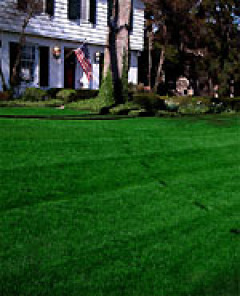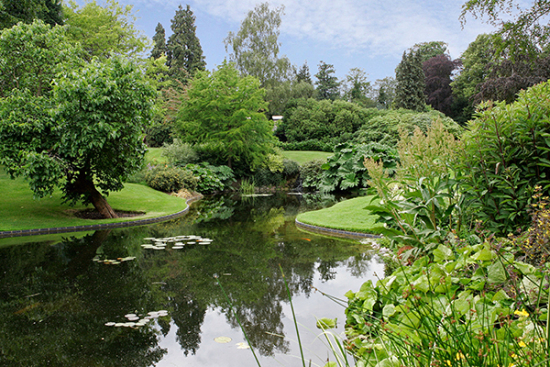An annual re-post -
 We always contend that lawns are foolish things to have. Foolish, and unnatural. We prefer meadows and gardens, but everybody needs a place to play croquet or softball, or to lie in the sun with a book, growing your basal cell carcinomas and your liver spots. We reluctantly acknowledge that, in some suburban areas, a sweeping lawn is a social if not an aesthetic requirement.
We always contend that lawns are foolish things to have. Foolish, and unnatural. We prefer meadows and gardens, but everybody needs a place to play croquet or softball, or to lie in the sun with a book, growing your basal cell carcinomas and your liver spots. We reluctantly acknowledge that, in some suburban areas, a sweeping lawn is a social if not an aesthetic requirement.
All the same, we urge folks to consider how much of that lawn they might exchange for some more interesting colorful perennial or shrub borders and ground covers. A nice English garden, whether formal or informal, uses lawn as an accent and for paths - as just one component of design and mentally, I think, as a comforting symbol of safe civilization to contrast with the blooming profusion of the other plantings. Order vs. disorder. Open vs. closed. Safe vs. mysterious. Landscape design is a psycho-spiritual enterprise. This is a garden outside of London:

Here's a brief history of the American lawn. Yes, the lawn is more-or-less designed to imitate the smooth effect of a sheep-grazed pasture on an English country estate.
And here is our world-famous bit on top-dressing and other lawn topics.
Today, a bit about lawn aeration, fertilizer, irrigation, earthworms, and "de-thatching." In reverse order:
 "De-thatching" is a completely useless and unnecessary activity. No healthy soil needs it, and a healthy soil is the key to a decent sod. "Thatch" - old grass - will rapidly decompose or be eaten by worms in a good lawn, recycling the nutrients and keeping your worms fat and happy.
"De-thatching" is a completely useless and unnecessary activity. No healthy soil needs it, and a healthy soil is the key to a decent sod. "Thatch" - old grass - will rapidly decompose or be eaten by worms in a good lawn, recycling the nutrients and keeping your worms fat and happy.
Earthworms. We said everything we know about the wonderful earthworm in this post. They aerate and enrich the sod. If your sod doesn't contain plenty of them, something is wrong with it.
Irrigation. No natural lawn requires irrigation. If you try to grow lawn grasses in places they don't want to grow, like the Arizona desert, they will need irrigation of course. Around here, people with money to burn irrigate their lawns to trick the grass into staying green all summer, and not enter their natural summer dormancy when they are apt to turn brown. Lawn grasses grow the way they do because our mowing cuts their tops off while they keep trying to grow to their natural height and to bear their seeds. It must be frustrating to the poor things. In natural conditions, grasses grow to their full height, bear their seeds (say, in early July) and then go dormant until cool damp weather brings them back to life. If you keep them strugging at their Sisyphisian effort through the mid-summer with irrigation, they will naturally need more fertilizer to look photogenic.
Fertilizer and top-dressing. Our lawns do need fertilizer because they are deprived of natural sources of nutrients (fallen leaves, animal droppings, clover and other wild legumes with their nitrogen-fixing bacteria, silting from flooding, etc). When you bag or blow the clippings, then even more so - and you starve the worms, too. My top-dressing program not only fertilizes organically, but also improves the soil texture. I also fertilize lawns in June and September/October. I don't use water-soluble nitrogen, because most that will end up in the stream. I use mowing machines that mulch the clippings and fallen leaves. I don't need to use herbicides, because the grass is happy. And I don't use pesticides because there is no good reason to waste the money and to poison Creation.
Aeration. In nature, earthworms, moles, woodchucks, and other digging critters keep the topsoil loose and in motion. Loose soil is need for root growth, water and nutrient penetration, and to provide air for aerobic soil microbes. Our lawns tend to get compacted, and people try to kill their happy moles because they interfere with the "perfect lawn" (which, of course, is meant to be a reflection of our perfect selves, right?). Aeration of lawns and sports fields is essential, and should be done depending on how heavily the grass is tromped on. Some lawns, every two years. Sports fields need twice per year. There are two kinds of aerators. The spike aerators (like this) do nothing useful. What is needed is the plugger type (like this one, in photo above), which pulls out forty-fifty per square yard 2-4"-deep plugs out of the sod and deposits them on the surface. (it makes a temporary mess, but one good heavy rain removes most evidence of the plugs.) Plug aeration is commonly done in the Fall, but I like to do it in the Spring, after the grass gets growing thick and vigorously (May), and combine it with my biennial top-dressing project and with any overseeding that seems needed.
The downside of plugging is having dogs with muddy feet on your bed for a couple of days.


 We always contend that lawns are foolish things to have. Foolish, and unnatural. We prefer meadows and gardens, but everybody needs a place to play croquet or softball, or to lie in the sun with a book, growing your basal cell carcinomas and your liver spots. We reluctantly acknowledge that, in some suburban areas, a sweeping lawn is a social if not an aesthetic requirement.
We always contend that lawns are foolish things to have. Foolish, and unnatural. We prefer meadows and gardens, but everybody needs a place to play croquet or softball, or to lie in the sun with a book, growing your basal cell carcinomas and your liver spots. We reluctantly acknowledge that, in some suburban areas, a sweeping lawn is a social if not an aesthetic requirement. 
 "De-thatching" is a completely useless and unnecessary activity. No healthy soil needs it, and a healthy soil is the key to a decent sod. "Thatch" - old grass - will rapidly decompose or be eaten by worms in a good lawn, recycling the nutrients and keeping your worms fat and happy.
"De-thatching" is a completely useless and unnecessary activity. No healthy soil needs it, and a healthy soil is the key to a decent sod. "Thatch" - old grass - will rapidly decompose or be eaten by worms in a good lawn, recycling the nutrients and keeping your worms fat and happy.